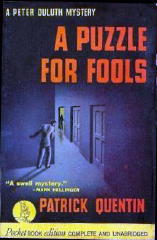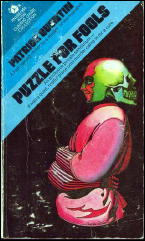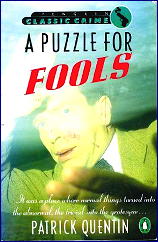Tue 21 Jul 2009
A 1001 MIDNIGHTS review: PATRICK QUENTIN – A Puzzle for Fools.
Posted by Steve under 1001 Midnights , Reviews[2] Comments
by Newell Dunlap & Marcia Muller:
PATRICK QUENTIN – A Puzzle for Fools.

Simon & Schuster, US, hardcover, 1936. Victor Gollancz, UK, hc, 1936. Paperback reprints include: Pocket #83, 1940, with several later printings; Dell D192, Great Mystery Library #4, 1957; Ballantine F461, 1963; Avon PN238, 1969, with at least one later printing. Trade paperback: Penguin Classic Crime, 1986.
Patrick Quentin is a pseudonym of the collaborative team of Hugh Wheeler and Richard Wilson Webb — who also wrote as Quentin Patrick. From 1936 to 1952, the pair produced a series of successful novels featuring Peter Duluth, a former Broadway producer and recovering alcoholic, and his wife, Iris.
After 1952, Wheeler went on alone to write seven more novels under the Quentin name, four of them featuring a New York police detective, Lieutenant Timothy Trant (who also appears in novels by Wheeler and Webb under the Quentin Patrick — or, in the original editions, Q. Patrick — pseudonym).

The novels are well written and well characterized, and frequently the plots are as baffling as the pseudonyms under which they were created. The endings of these novels, be they as by Patrick Quentin or vice versa, are sure to both surprise and satisfy the fan of traditional mysteries.
A Puzzle for Fools opens in the expensive sanatorium where Peter Duluth has gone to dry out. Bad enough to be in a mental hospital, doubting your own sanity and the sanity of those about you, but what if you also begin hearing a voice whispering to you at night? And what if that voice sounds remarkably like your own? And what if that voice warns you to get away, for there will be murder?
This is Duluth’s plight. However, instead of doubting him, the director of the clinic believes every word and asks for his help in solving not only this particular puzzle but also several other strange goings-on around the clinic. Thus does Duluth become a sort of Sherlock Holmes at work in a mental institution.

Certainly Duluth, and the police, have their work cut out for them, because soon the whispering prophecy comes true and one of the staff members is murdered, only to be followed by the murder of one of the patients. This, of course, is a rich and fertile field for the whodunit, and Quentin handles it well; not only must all the patients be considered suspects, but all the staff members as well. And there are secrets to be discovered on both sides.
Other complex “puzzle” mysteries starring Peter Duluth include Puzzle for Players (1938), Puzzle for Puppets (1944), and Puzzle for Fiends (1946).
Among the novels featuring Lieutenant Timothy Trant are Death for Dear Clara (1937) and Death and the Maiden (1939), both as by Q. Patrick; and My Son, the Murderer (1954) and Family Skeletons (1965). Wheeler and Webb also wrote a series of mysteries under the pseudonym Jonathan Stagge.
———
Reprinted with permission from 1001 Midnights, edited by Bill Pronzini & Marcia Muller and published by The Battered Silicon Dispatch Box, 2007. Copyright � 1986, 2007 by the Pronzini-Muller Family Trust.
Editorial Comment: For another review of this book, see the one by Marv Lachman posted here not so long ago.
October 25th, 2018 at 10:45 am
[…] his climactic departure from the drunk tank with a winsome Juliet in his arms makes this “puzzle” seem like a mere […]
April 14th, 2021 at 10:27 am
[…] Classic Mysteries; Dead Yesterday; In Search of the Classic Mystery Novel; The Invisible Event; Mystery File (1); Mystery File (2); Only Detect; Seeing the World Through Books; […]